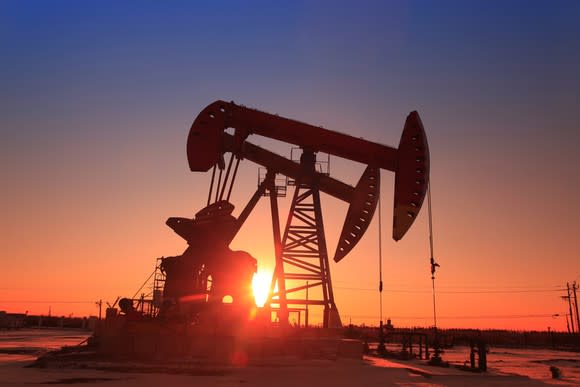Are Shale Drillers Unsuspectingly Running Out of Fuel?
Oil CEOs tend to be bullish to a fault. That leads them to make bold proclamations about a resource's potential that have fallen short more often than not. Some CEOs, though, are beginning to call into question the growth projections for shale production in the U.S., which they believe are too bullish. That's leading them to think that the country won't grow production as much as the market expects, which could cause a big spike in oil prices in the coming years.
Opening the taps
"The United States is set to put its stamp on global oil markets for the next five years," according to Dr. Fatih Birol, the head of the International Energy Agency (IEA). That's driving the IEA's view that the U.S. will overtake Russia as the world's largest oil producer within the next year. In fact, the IEA estimates that "over the next three years, gains from the United States alone will cover 80% of the world's demand growth." Overall, the IEA forecasts that the U.S. will pump out 17 million barrels per day (BPD) of petroleum products by 2023, which includes both oil and natural gas liquids, up from 13.2 million BPD last year. For comparison's sake, the IEA only expects OPEC's capacity to increase by 750,000 BPD over that time frame. Fueling the IEA's bullish view on U.S. oil are several monster shale fields in the country, led by the Permian Basin and Eagle Ford in Texas and the Bakken shale of North Dakota.

Image source: Getty Images.
Meanwhile, the U.S. Energy Information Administration (EIA) has a similarly bullish view. In its latest short-term energy outlook, the EIA estimated that the U.S. will pump 10.6 million BPD of oil this year, up from 9.3 million BPD last year. That level would drive America's oil output past the previous peak of 9.6 million BPD set in 1970. The EIA also expects the country to boost production to an average of 11.2 million BPD next year.
Running out of runway?
Some oil industry executives don't think the country can hit those numbers. One of them is Mark Papa, who currently leads Centennial Resource Development (NASDAQ: CDEV) after building EOG Resources (NYSE: EOG) into a shale giant. On Centennial's most recent conference call, Papa provided "some thoughts regarding the oil macro picture," noting that "many forecasting agencies estimate U.S. oil growth of between 1.4 million and 2 million barrels of oil a day this year." However, Papa stated that he still believes that "actual U.S. growth will be less than many forecasters are currently predicting," which will support much higher oil prices in 2019 and beyond. He's not the only one who thinks these government agencies are overestimating the potential of shale producers to keep growing. Continental Resources (NYSE: CLR) CEO Harold Hamm has also questioned the EIA's forecast, which he thought was overly optimistic.

Image source: Getty Images.
The reason these CEOs don't believe supplies will grow as fast as expected is that many drillers have already used up their best locations, especially in places like the Bakken and Eagle Ford. We see a glimpse of that in the remaining drillable inventory at Papa's former company. In the Bakken Shale, for example, EOG Resources' acreage position holds 2,100 total drilling locations. However, only about 330 of the remaining sites meet the company's return criteria. In the Eagle Ford, meanwhile, the company had 7,200 total locations, but just 2,425 premium return sites remain. While EOG Resources has added high-quality locations to its inventory over the past year by uncovering new high-return sites in places such as in the STACK shale play of Oklahoma and the Permian, many other drillers are using up their best spots.
With fewer top-tier locations remaining, many shale drillers are holding back this year, opting to generate free cash and increase shareholder distributions instead of drilling at full throttle. EOG, for example, recently increased its dividend 10% and said it could generate $1.5 billion in free cash if crude averages $60 a barrel this year. That's a change from the company's prior forecast that it would use all its operating cash flow to increase production by a 25% compound annual rate through 2020 if crude was in the $60s. Continental Resources, likewise, isn't pouring all its cash flow into more wells, choosing instead to generate $800 million to $900 million in free cash this year if crude remains in the $60s. While a shift in investor sentiment away from rewarding companies that grow at all costs toward those that create value has caused companies to hold back the throttle, it's also possible that producers want to save some of their best locations for higher oil prices rather than drill through all of them while crude remains low.
This bearish view is very bullish for oil stocks
Several well-respected analytical groups believe that the U.S. shale industry will unleash a flood of new oil over the next few years, catapulting the country to the top of the global leaderboard and likely keeping a lid on crude prices. But not all oil executives agree with this view. Some believe the industry has already drilled through a large portion of its best locations and therefore doesn't have enough fuel to grow that fast. If they're right, then oil prices could rise much higher in the coming years since supplies might not keep pace with demand, which could potentially drive oil stock prices up as well.
More From The Motley Fool
Matthew DiLallo has no position in any of the stocks mentioned. The Motley Fool has no position in any of the stocks mentioned. The Motley Fool has a disclosure policy.
